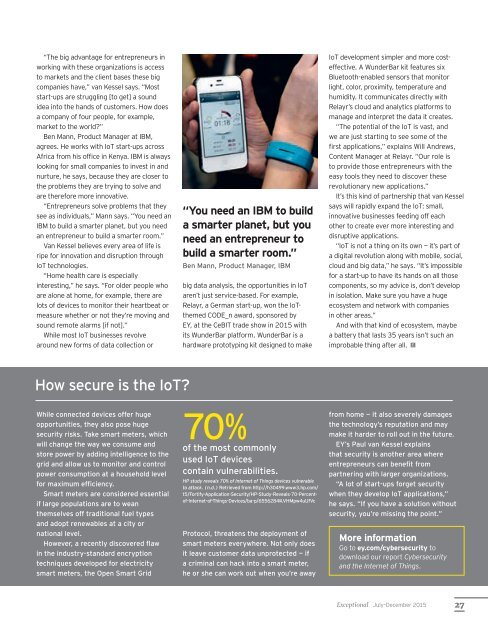Exceptional
Ua1bc
Ua1bc
Create successful ePaper yourself
Turn your PDF publications into a flip-book with our unique Google optimized e-Paper software.
“The big advantage for entrepreneurs in<br />
working with these organizations is access<br />
to markets and the client bases these big<br />
companies have,” van Kessel says. “Most<br />
start-ups are struggling [to get] a sound<br />
idea into the hands of customers. How does<br />
a company of four people, for example,<br />
market to the world?”<br />
Ben Mann, Product Manager at IBM,<br />
agrees. He works with IoT start-ups across<br />
Africa from his office in Kenya. IBM is always<br />
looking for small companies to invest in and<br />
nurture, he says, because they are closer to<br />
the problems they are trying to solve and<br />
are therefore more innovative.<br />
“Entrepreneurs solve problems that they<br />
see as individuals,” Mann says. “You need an<br />
IBM to build a smarter planet, but you need<br />
an entrepreneur to build a smarter room.”<br />
Van Kessel believes every area of life is<br />
ripe for innovation and disruption through<br />
IoT technologies.<br />
“Home health care is especially<br />
interesting,” he says. “For older people who<br />
are alone at home, for example, there are<br />
lots of devices to monitor their heartbeat or<br />
measure whether or not they’re moving and<br />
sound remote alarms [if not].”<br />
While most IoT businesses revolve<br />
around new forms of data collection or<br />
“You need an IBM to build<br />
a smarter planet, but you<br />
need an entrepreneur to<br />
build a smarter room.”<br />
Ben Mann, Product Manager, IBM<br />
big data analysis, the opportunities in IoT<br />
aren’t just service-based. For example,<br />
Relayr, a German start-up, won the IoTthemed<br />
CODE_n award, sponsored by<br />
EY, at the CeBIT trade show in 2015 with<br />
its WunderBar platform. WunderBar is a<br />
hardware prototyping kit designed to make<br />
IoT development simpler and more costeffective.<br />
A WunderBar kit features six<br />
Bluetooth-enabled sensors that monitor<br />
light, color, proximity, temperature and<br />
humidity. It communicates directly with<br />
Relayr’s cloud and analytics platforms to<br />
manage and interpret the data it creates.<br />
“The potential of the IoT is vast, and<br />
we are just starting to see some of the<br />
first applications,” explains Will Andrews,<br />
Content Manager at Relayr. “Our role is<br />
to provide those entrepreneurs with the<br />
easy tools they need to discover these<br />
revolutionary new applications.”<br />
It’s this kind of partnership that van Kessel<br />
says will rapidly expand the IoT: small,<br />
innovative businesses feeding off each<br />
other to create ever more interesting and<br />
disruptive applications.<br />
“IoT is not a thing on its own — it’s part of<br />
a digital revolution along with mobile, social,<br />
cloud and big data,” he says. “It’s impossible<br />
for a start-up to have its hands on all those<br />
components, so my advice is, don’t develop<br />
in isolation. Make sure you have a huge<br />
ecosystem and network with companies<br />
in other areas.”<br />
And with that kind of ecosystem, maybe<br />
a battery that lasts 35 years isn’t such an<br />
improbable thing after all.<br />
How secure is the IoT?<br />
While connected devices offer huge<br />
opportunities, they also pose huge<br />
security risks. Take smart meters, which<br />
will change the way we consume and<br />
store power by adding intelligence to the<br />
grid and allow us to monitor and control<br />
power consumption at a household level<br />
for maximum efficiency.<br />
Smart meters are considered essential<br />
if large populations are to wean<br />
themselves off traditional fuel types<br />
and adopt renewables at a city or<br />
national level.<br />
However, a recently discovered flaw<br />
in the industry-standard encryption<br />
techniques developed for electricity<br />
smart meters, the Open Smart Grid<br />
70%<br />
of the most commonly<br />
used IoT devices<br />
contain vulnerabilities.<br />
HP study reveals 70% of Internet of Things devices vulnerable<br />
to attack. (n.d.) Retrieved from http://h30499.www3.hp.com/<br />
t5/Fortify-Application-Security/HP-Study-Reveals-70-Percentof-Internet-of-Things-Devices/ba-p/6556284#.VHMpw4uUfVc<br />
Protocol, threatens the deployment of<br />
smart meters everywhere. Not only does<br />
it leave customer data unprotected — if<br />
a criminal can hack into a smart meter,<br />
he or she can work out when you’re away<br />
from home — it also severely damages<br />
the technology’s reputation and may<br />
make it harder to roll out in the future.<br />
EY’s Paul van Kessel explains<br />
that security is another area where<br />
entrepreneurs can benefit from<br />
partnering with larger organizations.<br />
“A lot of start-ups forget security<br />
when they develop IoT applications,”<br />
he says. “If you have a solution without<br />
security, you’re missing the point.”<br />
More information<br />
Go to ey.com/cybersecurity to<br />
download our report Cybersecurity<br />
and the Internet of Things.<br />
<strong>Exceptional</strong> July–December 2015 27









